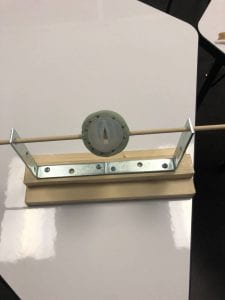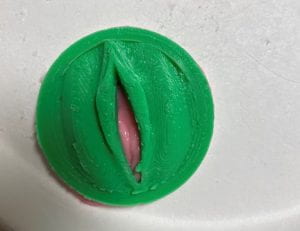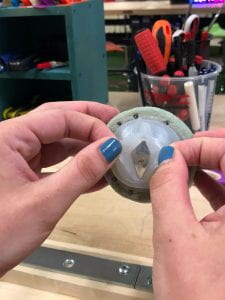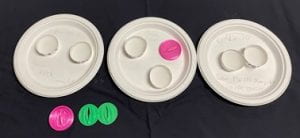*Content warning: My project deals with pediatric sexual abuse. Please exercise self-care while reading.
When Elise, Shannon, Alex and I demonstrated our low-fidelity “flip”, “twist”, and “swivel” models to our client over Zoom, we got some feedback that led us to consider aspects of our model we hadn’t, by any stretch of the imagination, thought about before. Sure, easy rotation like that of the “flip” model could be helpful, but what if nurses needed to be able to perform pelvic examinations regardless of whether they were sitting down or standing up? What if you had the (very probable) scenario of a child not positioning themselves at the most correct angle for the supine or prone orientations, and they were slightly tilted one way or the other? Our model needed to simulate the real pelvic exam experience.
This made the “swivel” model the clear winner – it was the only model that could freely rotate the labia and hymen to various angles above the horizontal. Still, our client pointed out that we’d need some sort of mechanism to lock the rod in various orientations, so it wouldn’t slip or swing when nurses interacted with the labia.

We decided to make a slightly higher-fidelity prototype of our swiveling model (especially since the low-fidelity one collapsed mid-Zoom meeting…), and attach a Dragon Skin 10M labia model we constructed using the scaled-down LUCIA labia mold we 3d-printed last week.
It actually worked quite well! The main challenge we ran into, however, was that the weight was imbalanced, so the model would only hang at the correct angle in the prone position. So we knew we would need to brainstorm and prototype some rotation lock options in Week 4. We’re currently thinking about adding grooves to the ends of the rod and a notch to the holes in the frame, so the user can simply set the rod into the notch at the desired orientation.
And, given the fact that we had to nail the labia into the cylinder in the model… we’d need to brainstorm better attachment methods of the labia/hymen to the base, so that different labia and hymen varieties can be easily interchanged during practice pelvic examinations.
So we went (somewhat) back to the drawing board on attachment methods. Should we use a screw-on cap? Well, that would be secure, but it might be hard to always twist it on in the right orientation. How about a snap-on cap? Well, that might still rotate after snapping on. Buttons? A bayonet mount? An embroidery hoop? We’ve definitely been stretching our imaginations on how to attach things to the base.
And meanwhile, we’ve also been stretching something else – silicones! We finally began testing materials for the labia and hymen this past week, and the results have actually been quite surprising. Since the LUCIA project uses Dragon Skin for their labia, we were expecting Dragon Skin to work the best for our project… but what we realized was that because our model requires nurses to separate the labia with their fingers, it needs to better mimic the elasticity of human skin. What we found was that a different silicone rubber, called Ecoflex 30, seems to be the most promising in terms of elasticity. However, as user feedback is incredibly important for a training model, we are working to get input from local pediatric gynecologists on our sample labia models.



This coming week, now that we have a functional model frame and labia mold, we’ll be focusing a lot on improving our hymen and labia prototypes, creating prototypes with more materials, and constructing attachment and rotation lock mechanisms. One thing we did realize, as you might be able to tell in the Dragon Skin labia picture above, is that it’s difficult to grip the labia and separate them, since there’s so little surface area on the side. Our client gave us that same feedback during our prototype demonstration. So this week, we’ll also focus on altering the CAD design of the labia mold to incorporate more surface area on either side of the labia to better facilitate labial traction.

Overall, this week we dove headfirst into prototyping and the nitty-gritty of mixing and curing silicones, building frames, and working in CAD. But the mid-summer presentations at the end of the week made me take a huge step back and look again at the broader context of what we’re doing and why. I am genuinely so glad that our team has the opportunity to hopefully make such a significant impact on the quality and accessibility of clinical evaluations of pediatric sexual abuse and assault, and that we have such a wonderful support system at Rice 360 and the Texas Medical Center, full of people invested in helping our project succeed and encouraging us as people, friends, and colleagues. I can’t wait to see what these next couple of weeks bring.
-Shivani